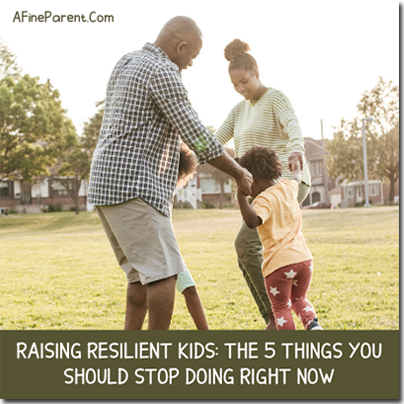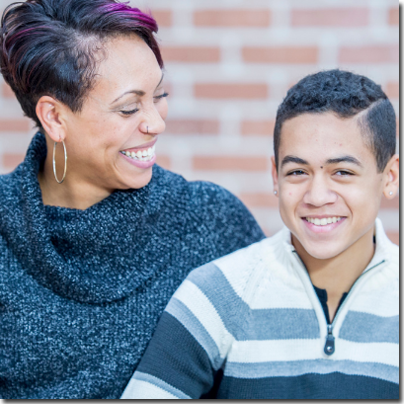 As my two-year-old son was playing on a crowded playground, he made a quick dash to climb up a ladder. I instantly sucked in a deep breath as he lumbered his way awkwardly up the steps. The urge to jump in and help him was strong…but I held back, only staying close by in case something went terribly wrong.
As my two-year-old son was playing on a crowded playground, he made a quick dash to climb up a ladder. I instantly sucked in a deep breath as he lumbered his way awkwardly up the steps. The urge to jump in and help him was strong…but I held back, only staying close by in case something went terribly wrong.
As he made it to the top of the ladder and turned around to give me a smile, my heart skipped a beat with pride; I was relieved that I had held back and allowed him to figure it out himself.
It is a natural instinct for parents to want to protect their children from adversity. While my son is young and adversity comes in the form of a playground ladder, I can imagine how this will shift and evolve as my son gets older. Learning basic motor skills and tackling self-care will move to making friends, being successful in school, overcoming peer pressure…and the list just goes on.
Our children MUST learn how to be resilient in order to find success and overcome the obstacles they will face as a human. If we sweep in to save our children from every bit of difficulty, we actually do them a disservice. We send the message that when life gets tough, someone will always help you out of it and that failure is a scary and negative thing.
In reality, one of the best things we can do for our children is to allow them to struggle, as it provides the chance to reframe failure. Every hard moment or struggle is an opportunity to learn resilience!
Resiliency does not usually come naturally to our kids. We, as parents, can help them overcome difficulty – although this may also not come naturally to us! Most of us likely say or do things, at times, that unintentionally get in the way of raising gritty, independent kids. Here are 5 things we should stop doing right now to raise resilient kids!
Stop: Saying “Be Careful”
 I’m guessing I’m not the only one who has had a playground moment in which the “be careful” has been on the tip of your tongue a million times over. If you are anything like me, you are not always successful in biting your tongue.
I’m guessing I’m not the only one who has had a playground moment in which the “be careful” has been on the tip of your tongue a million times over. If you are anything like me, you are not always successful in biting your tongue.
Children learn best through interactions with the world and sometimes those interactions are through risks. While we certainly want our kids to be safe, the phrase “be careful” doesn’t help with that because:
- What does “be careful” even mean to a child? For a young child especially, they don’t have the skills yet to know how to be careful.
- Once we yell “be careful,” the confidence our children once had could turn to fear that they are going to fail.
Instead, we want to expose our children to difficulty and risks while also managing to guide them through it safely.
Let’s go back to our playground example. When we see our kid looking to climb up a ladder, we can walk (or scurry!) quickly over to them and say something like:
“Wow, you are taking a risk! You got this. Tell me about your plan to get up. What’s next? Are you going to grip onto the ladder tightly and pay close attention to where you put your feet? Ok good. Does this feel safe to you? I will be right here watching if you start to feel not safe. Otherwise, I believe in you to get all the way to the top.”
Let’s break this down to understand the importance of the key phrases:
- “Wow, you are taking a risk!” By using the word “wow” and defining that climbing a ladder is a risk, we are letting our child know that risks are good and they should take them.
- “You got this.” We are showing our child that we have confidence in them.
- “Tell me about your plan to get up. What’s next?” This is our alternative to be careful. We are letting our toddler know that when we take risks, we need to have a plan of action. We shouldn’t go blindly into them.
- “Are you going to grip onto the ladder tightly and pay close attention to where you put your feet? Ok good.” We are giving our child specific ways to be safe while climbing the ladder. This is especially important when the risk they are taking is also a first-time experience…and can be faded as the novelty of the challenge wears out!
- “Does this feel safe to you? I will be right here watching if you start to feel not safe.” We are teaching our child to check in with their body. If they don’t feel safe, they should listen to that feeling. We are also reassuring them of our presence in case safety becomes compromised.
- “Otherwise, I believe in you to get all the way to the top.” We are bringing our confidence in them full circle, ending where we started.
Eliminating “be careful” from our vocabulary won’t happen overnight, but we can start to practice other ways to offer support and overtime, our confidence in allowing our kids to take risks will start to grow.
Stop: Providing Constant Entertainment
 One of my favorite authors, Matthew Kelly, constantly discusses how we need to sit in the classroom of silence. It is there where we can find the answer to some of life’s greatest questions and challenges. We can sit with our thoughts and come up with solutions or think up new ideas.
One of my favorite authors, Matthew Kelly, constantly discusses how we need to sit in the classroom of silence. It is there where we can find the answer to some of life’s greatest questions and challenges. We can sit with our thoughts and come up with solutions or think up new ideas.
The same is true for our children. They don’t need constant entertainment handed to them; doing so will create a roadblock to building resiliency.
The modern world of TVs, phones, devices, the belief that children need to be involved in 1.34 million extracurricular activities, and then the parenting guilt that can make us feel we are failing if we don’t constantly provide games and activities for our children to engage in can greatly interfere with allowing a child to be bored.
 Have you ever fallen into the trap of belief that allowing our children to be bored means we are parenting wrong? Cue the mom-guilt! We partnered with Suzi Lula to challenge conventional thinking in the Handling Mom Guilt Masterclass, and to convince mothers that when we thrive, our children also thrive.
Have you ever fallen into the trap of belief that allowing our children to be bored means we are parenting wrong? Cue the mom-guilt! We partnered with Suzi Lula to challenge conventional thinking in the Handling Mom Guilt Masterclass, and to convince mothers that when we thrive, our children also thrive.
This packed masterclass is one of the 70+ masterclasses you get when you join the AFineParent Academy today. Click here to learn more.
Allowing our children to be bored is actually a good thing. Here’s why:
- Boredom helps develop curiosity: Being bored allows kids to make discoveries about the world around them. They start to become curious and ask questions, which can lead to the exploration of new ideas. What can we do instead? Try limiting screen time, especially in places like the grocery store, dinnertime, car rides, and other places that could prompt curiosity and exploration.
- Boredom helps develop creativity: A study has recently found that creativity has started to decline in children. Children who constantly have full schedules and devices to distract their brains are not having the time or opportunity to foster their creativity. That means they need time to play pretend and problem solve with what they have right in front of them. What can we do instead? Try allowing more unstructured play time each day.
- Boredom helps develop independence: When we take the lead to fill up kids’ time with activities and entertainment, we aren’t giving kids a chance to manage their own time and come up with what they want to do or play on their own. What can we do instead? Try asking your children to come up with ideas about what they want to do or play.
When we allow our kids to be bored, we may actually start to see personalities that are far from boring because our kids have had a chance to explore the world and tap into resiliency skills.
Stop: Buying Random Toys
 Susie from Busy Toddler reminds us that not all toys are created equal, and it is so true! There is such a thing as good toys and bad toys. We want to buy toys that let kids lead instead of ones that do the work for them or are simply the hot new item that serves little positive purpose.
Susie from Busy Toddler reminds us that not all toys are created equal, and it is so true! There is such a thing as good toys and bad toys. We want to buy toys that let kids lead instead of ones that do the work for them or are simply the hot new item that serves little positive purpose.
A toy that allows a child to lead is one that:
- Grows with your child
- Allows your child to take the lead in unique and creative ways
- Isn’t loud, flashy, or does all the work for them
- Sturdy and durable
- Encourages pretend play
- Focuses on experiences
- Prompts memories
- Prompts storytelling
- Focuses on creative thinking
Taking the extra time to research toys and gifts instead of blindly buying whatever we first see can help ensure that the toys our children are playing with are encouraging the development of resiliency.
We may also find that the best kind of play comes from engagement with materials and items that are not even considered toys. A recent Harris Interactive survey found that 95% of teachers believe that hands-on learning increases confidence, and with confidence comes resiliency. While hands-on learning is more regularly promoted within schools, it can happen at home too, and does not need to involve fancy or expensive toys. For example, we can encourage play using regular household items such as:
- Cardboard boxes, scissors and tape to make robot creations
- Blankets and furniture to make forts
- Pots, pans, and kitchen utensils to create a musical band
- Cans of food for stacking
- Spray bottles to play with outside
- Cotton balls to build a snowman
- Shaving cream on a cookie sheet
If you’ve ever bought your child an expensive toy only to find them playing with the box it came in, then you know that when given the opportunity, children will play with almost anything. The possibilities are endless!
Stop: Believing Your Example Isn’t Important
 I had to caution my husband to stop using the phrases “That was stupid,” or “I’m so dumb,” whenever he would mess up. If our kids start to think that mistakes are associated with being dumb or stupid, they are less likely to take risks or try something hard for fear of being those words.
I had to caution my husband to stop using the phrases “That was stupid,” or “I’m so dumb,” whenever he would mess up. If our kids start to think that mistakes are associated with being dumb or stupid, they are less likely to take risks or try something hard for fear of being those words.
While our son has thankfully not yet repeated those phrases, I have witnessed him mimic the sounds I make when I struggle to open something like a pesky lid on a jar. I grunt, make noises like “Errrr” and start yelling at the object. I noticed my son does the same when he is trying to get his toys out of the closet, and he can’t quite get them unstuck.
Watching him copy my behavior in the face of adversity is a good reminder that if we know our kids are watching us during those moments, of course they are also watching during our less than stellar moments.
The social learning theory revolves around the idea that people learn by watching others. Perhaps the most well-known test of social learning theory and parent-child behavior is the famous Bobo doll experiment. This experiment found that children most often exhibited the same behavior towards the Bobo doll that they witnessed the adult exhibit–whether it was aggressive or kind.
Given the impact that our actions clearly have on our children, it’s time to allow them to catch us failing! Whether we really make a mistake or make a fake one to teach our child, the real lesson is letting our kids know that everyone makes mistakes and that failure can be a positive opportunity. Allowing our children to see us fail gives them (and us!) two advantages:
- The opportunity to also model resilience rather than defeat
- The opportunity to normalize failure so that it does not feel so scary
The next time we experience a failure (or even an opportunity to “set up” a failure), we can try these things:
- Verbally recognize the failure. Oh man, I was putting together your new bookshelf, and I did it wrong. It’s okay. Mistakes happen.
- Verbally recognize that there is likely an emotion that comes with the failure. I feel pretty frustrated with this bookshelf.
- Then, model appropriate actions to take after the failure. I’m going to take a few deep breaths. Then, I am going to reread the directions, so I can get it right. I might even need to watch a YouTube video to teach me how to set it up. Putting this bookshelf is pretty hard, but I am confident that I will learn how to do it.
Our young kids often don’t realize that we, the parents, fail too. They are only exposed to a world where they are the ones making mistakes. When we open them up to a world where everyone makes mistakes, we are teaching them failure is not a big deal and we can always try again.
Stop: Expecting Resiliency to Happen Overnight
 It can be hard to have patience with our children, especially when they are melting down over the most seemingly minute things.
It can be hard to have patience with our children, especially when they are melting down over the most seemingly minute things.
When my son was learning to use the bathroom on his own he would often throw a fit about having to pull up his pants on his own. He would beg and plead for our help without putting in an ounce of effort on his own. Naturally, we were frustrated and losing patience.
Dr. Carla Naumburg, PhD stresses the importance of patience when it comes to parenting our kids through big emotions when she said:
When we get upset or frustrated and try to rush them through these challenging moments, our kids learn that their feelings aren’t safe, and they don’t learn how to effectively take care of themselves when they feel scared, angry, sad, or confused.
In working to reframe my thinking about patience, I started taking my own deep breaths and focused on showing compassion as my son learned to pull up his pants on his own–and it paid off! The patience that I gave reinforced to him that I was confident in his abilities to do the challenging task on his own.
While we can’t expect our children to learn and demonstrate resilience overnight, we can focus on giving them specific tools to practice flexibility and toughness, including:
- Model empathy when failure happens. Oh man, I see you are really disappointed. You wanted to do that better.
- Teach them to take deep breaths or use other calming strategies when angry or frustrated. Using a lion’s breath method may be a catchy way to get kids motivated to try deep breathing. Lion’s breath includes an inhale through the nose, followed by opening the mouth widely, stretching the tongue out of the mouth towards the chin, and then exhaling through the mouth loudly.
- Gently give a new perspective or quick tip to encourage them to try something again (without doing it for them). You could build that higher if you put the bigger blocks on the bottom and the smaller ones on top.
- Encourage children to take a break and let them know that it is okay to put something aside and try again later. Setting up a space in the house that is conducive to a calming area may be a good way of providing an outlet for a break when they need one.
- Teach them about growth mindset and phrases to use when they think they can’t do something.
- Help them realize when it is time to give up…at least for now! Some things just don’t work out despite our best efforts and attempts to learn or practicing how to do it. For the sake of their mental health, sometimes it’s best to focus on something else. It doesn’t mean that they have failed; rather that they learned to listen to their bodies and move on. Often, there is simply a missing skill that will develop naturally as a child gets older.
After weeks of practice and struggle, I heard my son walk into the bathroom and shut the door. I held my breath and patiently waited. After a few minutes, he emerged triumphantly, having handled all the steps on his own. What had started out as a once frustrating and impossible feat soon became an accomplishment that my son was so proud of doing because he worked so hard at it.
If you are anything like me, many of the above tips are habits that we may not even realize we are doing! In an effort to keep our children safe and protected, we may fall into the trap of helicopter parenting without even realizing it. By being conscious in our efforts to give patience, space, time, and grace in our expectations, we can raise resilient kids that will know how to problem solve, make hard decisions, cope with rejection, and be lifelong learners.
The 2-Minute Action Plan for Fine Parents
As you assess the current habits you may have that interfere with your child learning resiliency, take a few minutes to reflect on the following:
- Do you jump in and try to prevent your child from struggling?
- Do you solve all of your child’s problems for him/her?
- Do you use the phrase “be careful” a lot?
- How do you react to your own failures?
- What kinds of toys does your child own?
- Do you feel as if you need to constantly entertain your child with activities and screen time?
If you answered yes to any of the above, it may be a good indication that you and your child may benefit from a commitment to some of the above suggestions!
The Ongoing Action Plan for Fine Parents
As you move forward in seeking how best to use struggle as an opportunity for your child to grow and learn, it may be helpful to assess where you are now so you can compare it to where you will be! Here is one helpful way to monitor long-term progress:
- Notice how often you use the phrase “Be careful” and work to reframe that phrase to something more helpful.
- Be mindful of how often you work to entertain your child because you don’t want him/her to be bored. Gradually cut back on the amount of screentime and structured activities you use when your child starts to get restless with boredom.
- Next, take inventory of the kinds of toys you have. Get rid of those toys that do all the work and don’t challenge or spark creativity.
- Then, set up some planned moments where you can let your child catch you making mistakes. Model the appropriate response to failure.
- Finally, throw expectations out of the window and focus instead on giving patience as your child learns how to react to their own failures and struggles.
Thank you! I will.
Enjoyed this article. A pretty good read on some strategies to raise resilience levels in kids. I have been guilty of some of the things mentioned above, while in some other areas, I do make it an effort to let the kids learn on their own and avoid hand-holding too much unless it’s a health risk. Found the above article useful so thanks a lot for sharing.